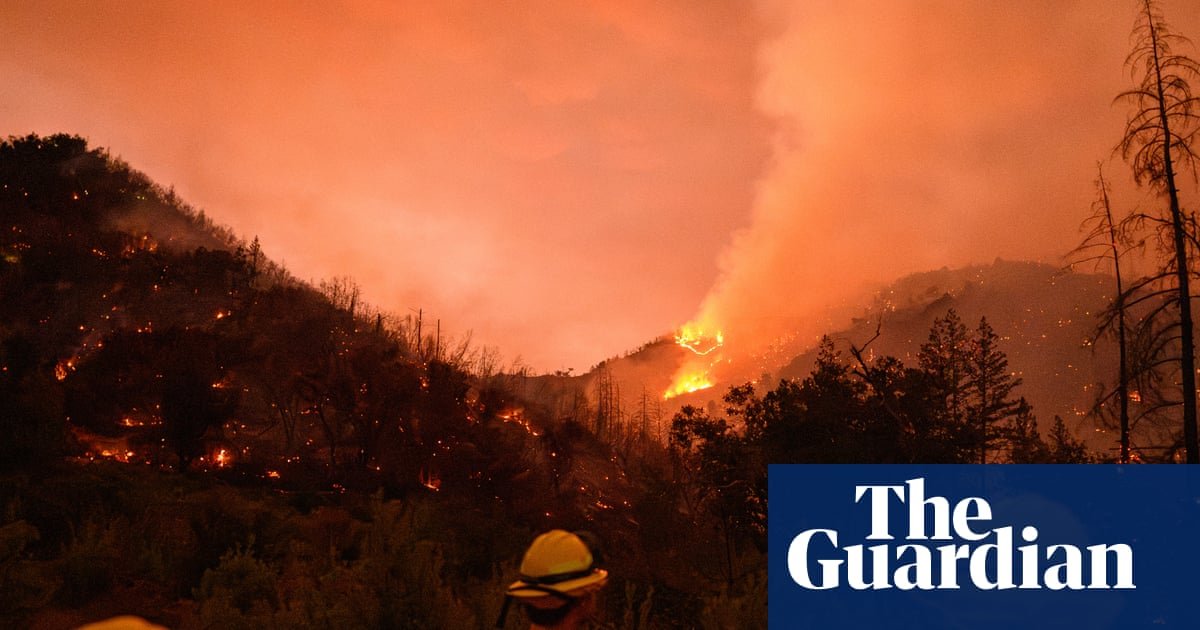Business
How to build a ship for interstellar travel

THE USS Enterprise they are not. One looks like a magic-marker pen, except that it is 58km long. The second, a pair of conjoined Ferris wheels. And the third, a giant jellyfish. They are, nevertheless, the winners of what may be the world’s first serious (or, at least, semi-serious) competition to design a ship to boldly go where no one has gone before, and settle a planet circling another star.
Business
Vineyards assess damage as wildfire rips through California wine country: ‘A devastating situation’ | California wildfires

Elton Slone and his colleagues at the Robert Craig Winery in Napa Valley had gathered for their annual pre-harvest company party last week – complete with copper pot carnitas and grape tacos – when one of his co-workers noticed an alert on her phone. The Pickett fire, a blaze that had started about 10 miles away near the town of Calistoga, was moving toward their vineyards on Howell Mountain.
Knowing that the Glass fire – a 2020 blaze that damaged numerous wineries and spoiled a year’s harvest – had burned along the same path, Slone hoped no fuel remained for this new fire. “But that was not the case,” he said. Within the week, the winery’s Candlestick Vineyard would become “a sacrificial lamb for the town of Angwin” when firefighters lit a controlled burn on their property to control the larger fire.
Vineyards can make excellent fire breaks because they are typically clear of burnable plant matter, and grape vines themselves are moist enough to be nonflammable. But heat damage and smoke can still destroy a crop.
The Robert Craig Winery lost the entire crop of their Candlestick Vineyard, which would have generated $4.5m in revenue. And Slone estimates about 10% of the vines will need to be replanted – a process that will cost hundreds of thousands of dollars and take a decade to see new bottles of wine ready for market. The team will test grapes on another one of their vineyards closer to harvest to see whether the smoke affected them.
The loss comes at the end of the growing season – after Slone’s vineyard had sunk nearly $1m into farming costs – and is made even more devastating because it’s happened before. The memories of the 2020 Glass fire and 2018 Camp fire, which burned farther east but still sent smoke to blanket Napa’s grapevines, are still fresh. “It’s financially a devastating situation,” said Slone.
The still-burning Pickett fire, which began on 21 August in northern Napa county, quickly burned through 6,800 acres (2,750 hectares), making it the San Francisco Bay Area’s largest wildfire this year. Preliminary estimates show that it caused $65m in agricultural losses, largely to wine grape growers, affecting about 1,500 acres (610 hectares) of agricultural land.
Although that damage is significantly less than that wrought by the Glass fire – which burned through 67,000 acres (27,000 hectares) and racked up $3.7bn in losses – the growing threat of wildfires in arid California has still shaken the wine industry.
“Northern California wine country is one of the treasures of the United States,” said Slone. “It’s something that I think all Americans should be concerned about because it’s a uniquely American thing.”
‘Tastes like a campfire’
Along the west coast, wine grape growers have implemented many strategies to prepare for wildfires – with the support of scientists at the US Department of Agriculture and local universities.
Ben Montpetit, chair of the University of California, Davis’s viticulture and enology department, said in an emailed statement that the industry has employed “barrier sprays to reduce smoke uptake, annual testing to establish baseline smoke marker levels in grapes, and small-lot fermentations after smoke events to assess potential wine impact”.
“Researchers are also investigating which grape cultivars are more sensitive or tolerant to smoke exposure,” he added.
“We’ve made a lot of progress in the preparedness realm,” said Natalie Collins, president of the California Association of Winegrape Growers, who noted the industry established a smoke exposure taskforce after the losses in 2018 to aid growers after wildfires.
The existence of that taskforce hints at a perennial problem for vineyards: though they can often keep wildfire off their acres, there’s little that can keep smoke at bay. And if smoke sits in an area for too long, it can leave grapes tasting ashy, like a campfire.
“Smoke taint issues are kind of fickle,” said Heather Griffin, a partner at Summit Lake Vineyards and Winery. “It depends on the varietal, depends on your ripeness level and depends on how long the exposure was.”
Griffin’s family’s vineyards were saved from the Pickett fire – “They stopped the fire at the end of our ridge up on Howell Mountain,” she said – but they’ll need to send grapes out for testing before harvest to be sure the smoke didn’t taint it.
Protecting the industry
For the first year ever, crop insurers are offering a new coverage option called the fire insurance protection smoke index endorsement, which would insure vineyards for losses due to smoke exposure.
But some growers say the cost of crop insurance has become unattainable after repeated wildfires.
“Our insurance went up so much after the fires of 2020. It literally went from $40,000 a year for really great coverage for all of our properties and inventory, and now it’s $300,000 a year and covers nothing,” said Slone.
For the 95% of Napa valley’s wineries that are family-owned, that cost can be “catastrophic”, he adds.
The wine industry has historically relied on federal funding to support USDA and university research into wildfire preparedness. Although those levels have remained steady despite widespread federal cuts, eight federal wine grape research scientists – including a smoke exposure specialist – were fired and then rehired early in the Trump administration’s Doge-era cuts.
“We want to make sure that an industry like ours continues to be protected,” said Collins, as “we continue to see the writing on the wall in California that wildfires likely will continue to be an issue here.”
It’s possible that some federal disaster relief funding may work its way to affected vineyards, but Griffin says buying wine from those wineries “helps everybody that’s up here”.
“Shoot them an email and buy some of their wine,” added Slone. “They will be the most appreciative people on the planet earth.”
Business
What the Cracker Barrel backlash shows about Maga’s influence on US culture | US news

It was supposed to be a simple rebrand – or so Cracker Barrel thought.
Earlier this month, the 56-year-old southern restaurant chain known for its country-store charm and nostalgic Americana aesthetic unveiled a new look: a minimalist logo, more modern interiors and a handful of new menu items.
Gone was the familiar image of “Uncle Herschel”, the old man in overalls leaning against a wooden barrel. Also dropped were the words “Old Country Store”. In their place: a pared-down gold background with the words “Cracker Barrel”.
It was the chain’s fifth logo change in its history and part of a broader push to stay relevant and attract young customers amid declining sales.
But what Cracker Barrel likely saw as a routine refresh quickly spiraled into a political storm, and made the company the latest target in the American right’s campaign against so-called “wokeness” in corporate America.
In conservative circles online, the backlash was swift.
“WTF is wrong with @CrackerBarrel??!” Donald Trump Jr posted on X. Conservative activist Christopher Rufo declared: “We must break the Barrel,” adding that “it’s not about this particular restaurant chain – who cares – but about creating massive pressure against companies that are considering any move that might appear to be ‘wokification’”.
“The implicit promise: Go woke, watch your stock price drop 20 percent, which is exactly what is happening now,” Rufo added.
Indeed, within days, Cracker Barrel’s stock slid more than 10%. And soon, the outrage reached the White House.
“Cracker Barrel should go back to the old logo, admit a mistake based on customer response (the ultimate Poll), and manage the company better than ever before,” Donald Trump wrote on social media on Tuesday morning. “Make Cracker Barrel a WINNER again.”
Later that day, Cracker Barrel reversed course.
“We said we would listen, and we have,” the company said. “Our new logo is going away and our ‘Old Timer’ will remain.”
A senior White House official revealed that Cracker Barrel executives had called the administration on Tuesday, and “thanked President Trump for weighing in on the issue of their iconic ‘original’ logo”.
The official added: “They wanted the President to know that they heard him, along with customer response” and that they would be restoring the old logo.
Trump celebrated the reversal as a win, and by Wednesday, the company’s stock had rebounded more than 8%. On Thursday, Cracker Barrel also reportedly removed a dedicated “Pride page” from its website.
For the rightwing online voices that drove the backlash, the reversal was another example of the influence they now wield in the US and one that has corporate America willing to bow before it in order to preserve its profits and avoid the hostility of the Maga movement.
One conservative influencer called it “a BIG win in the culture war for America”.
For some, it was no surprise that Cracker Barrel’s rebrand became a political flashpoint, as the company has long marketed a vision of “old country” America and has often been associated with conservative values.
“It has this kind of stylized or idealized representation of what I think many would define as the ‘good old days’,” Jarvis Sam, founder of the Rainbow Disruption and professor at Brown University and University of California, Berkeley, said earlier this week. “But for others, its imagery of histories of exclusion, of racial inequity and this romanticization of a time that was not that great, actually – it was not equally safe and nostalgic for everyone.”
Cracker Barrel, which was founded in 1969, has a documented history of sexual and racial discrimination accusations. In 1991, it adopted a policy that employees who failed “to demonstrate normal heterosexual values” would be terminated, which led to the firing of 11 LGBTQ+ employees and sparked protests.
In 2004, the company paid $8.7m to settle claims from more than 40 plaintiffs in 16 states alleging racist treatment of Black customers and discrimination against Black employees.
In recent years, the brand has drawn conservative backlash for making efforts to broaden its appeal and adopt more inclusive policies. It faced backlash in 2022 over adding meatless sausage to its menu and in 2023 for marking Pride Month on social media.
But Cracker Barrel is far from the only company to have found itself at the center of right-wing backlash campaigns over perceived “wokeness” in recent years.
In 2023, Bud Light lost nearly a quarter of its sales after partnering with Dylan Mulvaney, a transgender influencer. Just weeks later, Target pulled some Pride merchandise after facing backlash and threats to its stores. Chick-fil-A was also attacked for its diversity initiatives, and earlier this year, Trump himself slammed Jaguar Land Rover for what he called “stupid” and “woke” marketing.
“Go woke, go broke,” the White House said this week, referencing a phrase that has, over the years, become a rallying cry among conservative activists opposed to corporate America’s recent efforts to embrace diversity.
Rightwing commentator Rogan O’Handley, better known as DC Draino, who has more than 2 million followers on X, framed Cracker Barrel’s reversal as proof of Maga’s current cultural influence.
“We boycotted Bud Light and made them lose billions for going woke,” Draino said. “We boycotted Target and made them lose billions for going woke. Then we boycotted Cracker Barrel and they brought back the southern gentleman within a week. Maga is the most dominant political movement in our lifetimes. And we’re just getting started.”
Nooshin Warren, a marketing professor at the University of Arizona who studies political and cause-based marketing, said that companies often take their cues from those in power – whether it’s the president, the legislature or the courts.
They do so, Warren said, because they “believe that the power is mirroring the majority in a democratic setting” and thus believe it “mirrors the majority ideology, which is their market”.
In recent years, companies have increasingly sought to align themselves with social values in part as an effort to engage with younger and increasingly socially conscious consumers, and boycotts of companies have emerged on both sides of the political spectrum.
While it is not necessarily new that consumers want brands to be aligned with their values, Warren said, the difference now is the amplification.
“We didn’t have an amplifier and social media has brought that, and because we have that, generally the loudest people are more heard,” Warren said.
She said that the Cracker Barrel controversy, along with broader backlash against brands over their perceived political stances over the years, reflects a wider cultural shift in the US.
“We are a politically charged country right now,” Warren said. “Where almost everything is political, because almost every part of our emotions, household decisions, personal decisions, all has some sort of political value attached to it at this moment.”
On top of that, Warren said, “when we get institutional legitimacy from the top, most popular, most influential people in a country, that will also definitely add to it”.
Since returning to office, the Trump administration has sought to influence corporate behavior, pushing its rightwing policies and perspectives and seeking to suppress or eliminate support for LGBTQ+ rights and diversity.
According to the Wall Street Journal, corporations such as Mastercard, PepsiCo, Citi and others have scaled back their Pride marketing and sponsorships, citing both political pressure from the administration and growing economic uncertainty tied to tariffs.
In the entertainment industry, Variety reported that Discovery, Amazon, Paramount Global and Disney have begun unwinding their DEI initiatives. Walmart and McDonald’s have also recently pared down their diversity-related initiatives.
An April survey by Gravity Research found that nearly 40% of major US brands planned to “reduce Pride-related engagement in 2025” and none reported plans to increase it.
David Reibstein, a marketing professor at the University of Pennsylvania’s Wharton School, said that Cracker Barrel’s logo change “should have been no big thing”.
“Companies rebrand all the time,” he said, adding that he believes it likely “would have gone under the radar if it had not suddenly caught a couple people’s attention and wanted to make it into a political issue”.
Reibstein said that he has never seen a US president “sort of endorsing or condemning companies” in the way that Trump does: “Trump is an influencer, and when Trump says this company better change, if they don’t, he’s got a whole group of followers that are going to start boycotting that product.”
While Reibstein doesn’t believe that Cracker Barrel’s rebrand was politically motivated, he said that once it caught fire online and the president got involved, the company pretty much had “no alternative but to acquiesce”.
Political pressure is also extending beyond companies, and is part of a growing effort by this administration and its allies to reshape not only company behavior but wider US cultural institutions, from the Smithsonian museums to higher education.
“The whole Maga crowd and the followers of Trump have tremendous influence right now,” Reibstein said.
Business
‘March of commercialisation’: writing is on the wall for Berlin’s nightclubs | Germany

A forlorn disco ball counting down the time remaining hangs at the entrance of the beloved Berlin club Wilde Renate, known only as Renate, which is rapidly heading into its final nights of wild abandon.
Unlike its more hyped cousin Berghain and posher late sister Watergate, Renate has long stood for a certain more relaxed type of Berlin-brand partying – more poor than sexy to borrow the capital’s lamented motto.
The club, a ramshackle garden leading to a maze-like block of derelict flats playing EDM, house and techno handpicked by live DJs on each floor, has welcomed visitors from across the city and around the world for 18 years.
Instead of dress codes and picky or menacing bouncers, there were “welcoming” bartenders and a vibe like a “giant house party”, said guests on a recent Friday night. There were even rumours of a resident cat.
“I’ve always loved this old building with all its levels,” said Philipp Wittwer, a 34-year-old engineer out with friends. “It’s like a haunted house – there are so many rooms I’ve never seen, even after coming for years.”
But in late December the bash will be over. And for several other clubs making up the city’s unique nightlife, the writing is on the wall.
Many cities including London, Paris and New York have experienced a rash of late-night venue closures, creating depressing “night-time deserts” where there once was a vibrant scene.
But for a European capital that like no other built its reputation on fun and decadence, the pain is especially palpable in Berlin. Before the pandemic, the industry contributed, directly and indirectly, about €1.5bn (£1.3bn) to the chronically cash-strapped economy each year.
According to the left-leaning daily Tageszeitung, Clubsterben (the death of clubs) will fuel “the march of commercialisation” in Berlin. It said: “When they only open for snot-nosed brats, solvent tourists or company events, you’ll hardly be able to speak of ‘Berlin club culture’.”
Nightlife veterans at Renate also saw the ground shifting beneath their feet.
Berliner Rouven Kelling, 30, said: “If the alternative places all die out then all you’ll have are the mainstream clubs where you hear the same music everywhere and only drink Aperol Spritzes. Then we’ll get the kind of tourists we don’t want – it’ll be all Instagram models and TikTok people.”
As low-tempo techno with French pop samples drifted from the speakers, Rodrigo Lobos, 29, a warehouse manager from Sweden, said the “chill atmosphere” had lured him and his girlfriend, Emily Solis, 25, into Renate.
“In Stockholm the clubs close at 3am but here you can go non-stop,” he said, sipping a beer he said would cost him twice as much back home.
Solis, a receptionist, said she’d see little point in making the trip if Berlin’s fabled clubs vanished: “I’m here for the party.”
The reasons for Renate’s looming demise are multifaceted.
The owner of the site, a major local property developer, reportedly wants to build on the site of Renate’s cherished garden.
Unlike Berghain, the techno temple and hedonist attraction that helped put the city on the global party map in the 2000s, Renate does not own its own premises and its lease will run out at the end of the year. The club did not respond to requests for comment.
Popular spots Mensch Meier and Re:mise both closed in 2023, while institutions such as About Blank, Club Ost, OXI, VOID and Else have all appeared on the endangered list due in part to the planned expansion of an autobahn.
Laura Gülcker, 34, a product developer, said she came from a rural western German town once a year for clubbing.
She said that compared with “more corporate” discos with bottle service in cities like Düsseldorf, Berlin had spots that were “really relaxed, diverse – beautiful”. Gülcker likened Renate’s garden to an “enchanted forest” with its mature trees and rickety gazebos festooned with antique chandeliers.
Her friend Verena Tekaat, a 31-year-old working in the textile industry, said for two women heading into the night together, it was a big plus that Berlin’s nightclubs were not marooned in remote districts.
Emiko Gejic, spokesperson for the Clubcommission Berlin, representing the sector’s interests, said rising rents, soaring energy costs and the pressures of gentrification on the once-cheap and abundant real estate market have put the pinch on the nightclub scene, which traces its freewheeling origins to the Weimar republic a century ago.
Germany’s “oldest and biggest” gay disco, SchwuZ, this month declared itself bankrupt after nearly half a century in business, falling victim to inflation, management troubles and the existence of dating apps, among other factors.
Gejic said noise complaints had also driven many popular spots out of the city centre, as has the financial squeeze on people of peak clubbing age due to surging rents.
The drop in alcohol consumption among younger people has also sapped clubs of crucial income, leading many to hike prices at the door. Party nights now routinely cost €20 and upwards.
Low-cost airlines once delivered party people from across Europe to Berlin for a weekend bacchanalia, with many visitors forgoing a hotel in favour of a two-night dance marathon before collapsing into sleep on the return flight.
However, high taxes and airport fees at the little-loved new international hub BER have pushed budget carriers out of Berlin.
Today, a common fixture of the local party scene is a cluster of revellers gathered on benches outside a Späti (late-night convenience shop) with canned drinks and a playlist blasting from a mobile phone.
Gejic insisted all was not lost, noting the pioneer spirit that gave rise to clubs in abandoned industrial spaces after the Berlin Wall fell could be found in “young, community-based collectives” organising parties in unexpected places around town.
“I’m rather hopeful when I look at the scene creating new formats, getting involved, showing great solidarity and being politically active,” she said. “That’s the scene that I think will also break new ground in future.”
-
Tools & Platforms3 weeks ago
Building Trust in Military AI Starts with Opening the Black Box – War on the Rocks
-

 Ethics & Policy1 month ago
Ethics & Policy1 month agoSDAIA Supports Saudi Arabia’s Leadership in Shaping Global AI Ethics, Policy, and Research – وكالة الأنباء السعودية
-

 Events & Conferences3 months ago
Events & Conferences3 months agoJourney to 1000 models: Scaling Instagram’s recommendation system
-

 Jobs & Careers2 months ago
Jobs & Careers2 months agoMumbai-based Perplexity Alternative Has 60k+ Users Without Funding
-

 Funding & Business2 months ago
Funding & Business2 months agoKayak and Expedia race to build AI travel agents that turn social posts into itineraries
-

 Education2 months ago
Education2 months agoVEX Robotics launches AI-powered classroom robotics system
-

 Podcasts & Talks2 months ago
Podcasts & Talks2 months agoHappy 4th of July! 🎆 Made with Veo 3 in Gemini
-

 Podcasts & Talks2 months ago
Podcasts & Talks2 months agoOpenAI 🤝 @teamganassi
-

 Mergers & Acquisitions2 months ago
Mergers & Acquisitions2 months agoDonald Trump suggests US government review subsidies to Elon Musk’s companies
-

 Jobs & Careers2 months ago
Jobs & Careers2 months agoAstrophel Aerospace Raises ₹6.84 Crore to Build Reusable Launch Vehicle





















